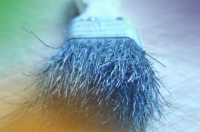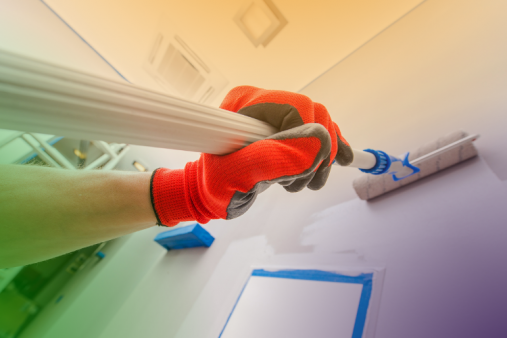How to Paint Interior Doors: A Step-by-Step Guide
Painting interior doors is an excellent way to freshen up a space without a full renovation. Whether you're updating tired white doors or going bold with a new colour, this guide walks you through the process from prep to perfect finish.
Materials & Tools You'll Need
-
Dust sheets or old towels
-
Screwdriver (to remove door handles and hardware)
-
Masking tape or painter's tape
-
Sugar soap or mild detergent
-
Sandpaper (120–180 grit) or sanding sponge
-
Tack cloth or vacuum with brush attachment
-
Primer or undercoat (if needed)
-
Wood paint (satinwood, eggshell, or gloss)
-
Angled and flat paintbrushes
-
Small foam roller and tray
-
Filler and putty knife (for dents or chips)
-
Door stoppers or blocks (to steady door)
Preparation Time:
-
Cleaning and sanding: 45–60 minutes
-
Masking and setup: 15–30 minutes
-
Drying time between coats: 4–8 hours (check tin)
-
Total time (over 1–2 days): 4–6 hours of active work
Step-by-Step Instructions
Step 1: Remove or Protect Hardware
Remove door handles, locks, and any other removable hardware. If you prefer to leave them on, carefully mask them with painter’s tape.
Step 2: Clean the Door Thoroughly
Use sugar soap or a mild cleaning solution to remove grease, dirt, and fingerprints. Wipe down with a damp cloth and let it dry fully.
Step 3: Fill and Repair Any Damage
Use wood filler to patch dents, scratches or holes. Once dry, sand smooth using fine-grit sandpaper.
Step 4: Sand the Surface
Lightly sand the entire door, especially if it has a glossy or previously painted finish. This helps the new paint to stick better. Clean off all dust using a tack cloth or hoover.
Step 5: Mask and Protect Surrounding Areas
Lay down dust sheets and tape around hinges, glass panes (if any), and adjacent walls or flooring.
Step 6: Prime (if needed)
If the door is bare wood, stained, or a dark colour you’re covering with a lighter shade, apply a suitable primer or undercoat. Let it dry completely.
Step 7: Apply the First Coat of Paint
Use a brush to cut in along edges, panels, and details, then a foam roller for flat surfaces. Paint in the following order:
-
Edges
-
Panels (if applicable)
-
Vertical stiles (sides of door)
-
Horizontal rails (top, bottom, and middle)
Use long, even strokes and avoid overloading the brush or roller.
Step 8: Allow to Dry, Then Lightly Sand
Let the first coat dry for 4–6 hours (water-based) or up to 16 hours (oil-based). Once dry, lightly sand for a smoother finish and wipe away the dust.
Step 9: Apply a Second Coat
Repeat the process with your second coat. This will give a more even, durable finish. Let it dry fully before refitting hardware.
Step 10: Reattach Hardware & Clean Up
Once the paint has dried completely, reattach handles and remove all masking tape carefully.
Drying & Curing Times (Typical Guide)
| Paint Type | Touch Dry | Recoat Time | Fully Cured |
|---|---|---|---|
| Water-based (satin/eggshell) | 1–2 hours | 4–6 hours | 5–7 days |
| Oil-based (gloss) | 6–8 hours | 16–24 hours | 7–10 days |
Always follow the manufacturer’s recommendations on the paint tin.
10 Frequently Asked Questions About Painting Interior Doors
1. Do I need to take the door off its hinges to paint it?
No, not usually. You can paint it in place, as long as it's properly supported and doesn’t swing. Use door stops or wedges to hold it steady.
2. What type of paint is best for interior doors?
Use satinwood, eggshell, or gloss formulated for wood and metal. Satinwood is popular for its low-sheen and durability, while gloss offers a traditional, high-shine look.
3. Can I paint over a previously painted door?
Yes — as long as you clean and sand it first. If the previous paint is glossy or oil-based, use a primer to ensure good adhesion.
4. Should I use a brush or a roller?
Use a brush for corners and detail, and a foam roller for flat areas to achieve a smooth finish with minimal brush marks.
5. Do I need to prime the door before painting?
Only if:
-
It’s bare or stained wood
-
You're switching from a dark to a light colour
-
The existing paint is oil-based and you're using water-based paint
6. How many coats do I need?
Usually two coats give the best finish, especially if you’ve used a primer or are changing colour.
7. How do I avoid brush marks on the door?
Use long, even strokes, avoid overloading the brush, and finish each section while the paint is still wet. A foam roller can help eliminate visible strokes on flat panels.
8. How long should I wait before closing the door?
Wait until the door is dry to the touch — usually 6–8 hours for water-based paints. To avoid sticking, leave the door slightly ajar for 24 hours.
9. Should I paint the edges of the door too?
Yes — but a common practice is to paint the edge that is visible when the door is open the same colour as the side it faces.
10. What’s the best finish for high-traffic doors?
Use satinwood or gloss — both are more durable than matt or eggshell, making them ideal for doors that see frequent use.





